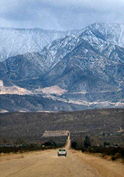
Road barriers
This road in the Lucerne Valley in the western Mojave is just one of the many roads crossing the Mojave that inhibit habitat connectivity.
Habitat Connectivity
Habitat connectivity is considered to be one of the most important factors in maintaining biological diversity.1 Maintaining gene flow is essential for genetic fitness and allows for adaptation to environmental changes. For some species with limited ranges, especially reptiles and small mammals, habitat loss can threaten survival of a population if species cannot migrate to suitable replacement habitat.2 Maintaining connectivity allows limited-range species to shift habitats to adjacent areas if populations experience loss of habitat. For larger species, habitat connectivity is required across a much larger swath of the landscape because resources are dispersed across a broader area.3 Individuals traveling between isolated populations allow gene flow to occur, which is important for avoiding inbreeding.
Many conservation initiatives are focused on maintaining habitat connectivity, particularly when increased urbanization threatens to fragment habitats. In 2000, several conservation and research organizations participated in a workshop for the purpose of identifying “linkages” between important core habitat areas across the State of California.4 Maintaining or reestablishing connectivity between these core areas is seen as critical for protecting the state’s biodiversity. Within the Mojave Desert ecoregion, the group identified 37 linkages, utilizing information on several species (including mammals, birds, amphibians, and reptiles).5 The group also identified primary barriers to migration, with highways and major roads accounting for nearly 70 percent of the existing barriers.6 As urbanization increases in the California desert, maintaining connectivity and mitigating existing barriers to migration are considered conservation priorities. In the face of climate change, which may require species to move in response to habitat shifts, connectivity to potential future habitats will be essential for adaptation.
1 C.W. BarrowsK.L. Penrod, E.S. Rubin, C. Paulman, Mojave Desert Habitat Connectivity ~ Phase 1: A Brief Overview of the Mojave Desert’s Previously Identified Areas of Ecological Significance, (Fair Oaks, CA: SC Wildlands, 2009)., M.F. Allen, “Conservation Implications of Fragmentation in Deserts,” in R.H. Webb, L.F. Fenstermaker, J.S. Heaton, D.L. Hughson, E.V. McDonald, and D.M. Miller, eds. The Mojave Desert: Ecosystem Processes and Sustainability, (Reno: The University of Nevada Press, 2009), 168-195.
2 K.L. Penrod, E.S. Rubin, C. Paulman, Mojave Desert Habitat Connectivity ~ Phase 1: A Brief Overview of the Mojave Desert’s Previously Identified Areas of Ecological Significance, (Fair Oaks, CA: SC Wildlands, 2009).
3 J.D. Wehausen, “Nelson Bighorn Sheep.” Found online: BLM California Desert District West Mojave Habitat Conservation Plan Species Accounts, Mammals page, http://www.blm.gov/ca/st/en/fo/cdd/wemo_species_mammals.html
4 K.L. Penrod, E.S. Rubin, C. Paulman, Mojave Desert Habitat Connectivity ~ Phase 1: A Brief Overview of the Mojave Desert’s Previously Identified Areas of Ecological Significance, (Fair Oaks, CA: SC Wildlands, 2009).
5 K.L. Penrod, E.S. Rubin, C. Paulman, Mojave Desert Habitat Connectivity ~ Phase 1: A Brief Overview of the Mojave Desert’s Previously Identified Areas of Ecological Significance, (Fair Oaks, CA: SC Wildlands, 2009).
6 K.L. Penrod, E.S. Rubin, C. Paulman, Mojave Desert Habitat Connectivity ~ Phase 1: A Brief Overview of the Mojave Desert’s Previously Identified Areas of Ecological Significance, (Fair Oaks, CA: SC Wildlands, 2009).
